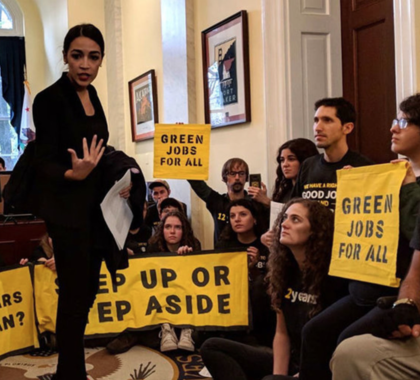The much-hyped Green New Deal (GND) is being pushed by a rump group of progressive-socialists in the Democratic Party, including prominent members of the Senate with stated presidential aspirations. If enacted, GND would constitute a complete socialist makeover/takeover of the economic system of the United States.
With costs in its first 10 years estimated at nearly $50 trillion dollars, GND would be by far the most costly social and economic experiment in U.S. history. For comparison, the United States has accumulated $21 trillion in debt over its 241-year history.
While recognizing GND would destroy the economy if adopted, I think is it much less dangerous as a proposal than the much more modest and varied iterations of a carbon dioxide tax that have been floated by various members of the Democratic and Republican parties. Why? Simply because GND is so far-reaching and economically wrenching, so enormous in scope and intrusive into peoples’ lives and livelihoods, it is far less likely to be enacted—at least in whole, in one massive piece of legislation—than a tax on fossil fuel use. The public is already used to paying gasoline taxes at the pump, along with surcharges on electric power bills and to airlines. Imposing a percent charge or dollar fee on fossil fuels, allowing its costs trickle down throughout the economy in the form of higher prices for goods and services, would allow politicians to escape the blame for the enormous damage the tax would do.
Most people complaining about the higher costs will mistakenly blame businesses for the raising prices, leaving the politicians and bureaucrats whose actions actually necessitated the higher costs scot-free. And if the past is any guide, the mainstream media will eagerly promote this false view of who is really to blame for higher prices.
GND, by contrast, is in your face. Voters will know whom to blame when it all goes wrong, costs skyrocket, unemployment rises, and electricity reliability declines. Given that the United States has regular, relatively free and fair elections, huge vested economic interests, and a history of periodic political whiplash in response to much more modest policy changes in the past, it would be virtually impossible to pass GND. That is why even the vast majority of the Democratic caucus is not yet supporting it.
In short, although taxing carbon dioxide emissions would cost billions of dollars, increase unemployment, hurt the economy, and limit personal freedom, it is entirely possible a carbon dioxide could pass. It’s unlikely with the current split Congress and with Donald Trump as president, but some relatively near-future Congress and president could certainly take the plunge.
GND, by contrast, would impose dramatic, wrenching changes that are simply not politically possible. (For the purposes of this essay, I’m limiting my discussion to the energy and environmental transformation that would be necessary to end fossil fuel use by 2030, though GND is also chock-full of social-justice and –engineering wish list items.)
Although it is possible to draw up a scenario in which GND could happen, with the stars aligning perfectly and every policy and economic change necessary to meet the goal of eliminating fossil fuels accomplished successfully, the real world is messy. People, politicians, and countries have differing, often competing, aspirations and visions of what the good life entails, and they make mistakes, fail to find expected and desperately needed resources, and miss deadlines. Those factors and the simple physical requirements of eliminating fossil fuels in 11 years mean GND is impossible, for all practical purposes.
Consider, for example, the massive change to the electric power grid and the U.S. transportation system necessary to replace fossil fuels with renewable power plants and electric vehicles in just 11 years. The electric grid and the transportation system were built up over 80 years or more. GND calls for replacing all of this in just a decade.
To meet current electric power needs, estimates are millions of wind turbines would have to be erected, millions of solar panels installed, and billions of battery packs stored in millions of homes or at tens of thousands of centralized battery farms that would have to be built. Wind turbines would have to cover one-third of the continental United States, or solar panels would probably have to cover more than 20 percent of the countryside, just to meet current demand. We would also have to erect thousands of additional electric towers and string thousands of additional miles of transmission lines to get the power from the locations where the wind blows and sun shines regularly—which is where the wind and solar farms will have to be built, of course—to the cities and towns where the power is needed. Talk about a devastating impact on wildlife and wilderness!
Of course, that’s just to meet the current demand for electric power. If domestic demand grows, we will need even more turbines, panels, and transmission lines than estimated. More likely, the havoc GND is almost certain to cause in the economy would result in the largest sustained depression and economic decline in the history of the United States, causing energy demand to fall as it has consistently done during previous recessions and depressions. For GND proponents, that might be a feature and not a bug, though they certainly aren’t going to tell you that.
Consider also the billions of dollars cities and investors would lose when the coal and natural gas powered municipal power plants and those operated by investor-owned utilities were idled prematurely by force of law. Stock portfolios would plunge, blowing a gigantic hole in retirees’ pension payouts. Taxpayers would likely be on the hook for billions of dollars to companies and investors when they are forced to close fossil fuel power plants before they are paid off and before the end of their productive lives—facilities which various state public utility authorities licensed and approved. The cost to taxpayers to pay off these stranded assets would be astronomical. Residents of cities with municipal power systems would still be paying off the debt for the bonds used to build their publicly owned power plants idled by GND long after the federal government stopped them from generating power.
And that’s just the effect on electric power. All gasoline, diesel, biodiesel, ethanol, and natural gas powered vehicles would have to be replaced with electric vehicles. A lot of people would surely object to being forced to mothball their vehicles, especially because the electric vehicles they would be forced into would be smaller, less powerful, less comfortable, more expensive, and unable go long distances without frequent recharging. People care about these factors more than fuel economy, which is why electric vehicle sales still make up less than 2 percent of the car and truck market despite more than a decade of generous government subsidies.
Transforming the automobile market would require a total revamping of the supply chain from factories to subcontractors. Foreign cars manufacturers would have to buy into GND also, if they wanted to keep sellling cars in the United States. Because other countries wouldn’t be bound by GND strictures, foreign auto manufacturers might decide to abandon the U.S. market for China, India, and elsewhere rather than going through the expensive restructuring and supply chain changes necessary to build only or primarily electric vehicles.
Proponents of GND admit the technological transformation required to hit the zero fossil fuel target by 2030 would be akin to a wartime effort. As in World War II but on an even larger scale, all manufacturing would have to be directed away from whatever products we build now—blenders, pump jacks, computers, etc.—to the production of millions of wind turbines, solar panels, electric vehicles, batteries, transmission towers and power lines, rail tracks, cars, engines, and associated technologies for our new green economy. The government would be conscripting all factories, and by extension their workers, into GND’s warlike crusade against chimeric climate change. And it would all be for naught, because global greenhouse gas emissions would continue to rise as a result of economic growth in developing countries that are not foolish enough to impose GND on themselves.
Meeting GND’s goals for home energy efficiency and resource use would require an unprecedented intrusion of government agents into our homes. They would have to come into almost every home to ensure each is fitted with the latest in energy efficient appliances, insulation, home heating and cooling systems, and windows. Say good-bye to your gas-powered stove, dryer, water heater, or fireplace, and toss out that propane grill. Those luxuries would have to be sacrificed under GND.
Under GND, the government would have to get up close and personal in everyone’s life, requiring, for example, people to purchase government-approved TVs, phones, refrigerators, and other home goods that use less energy. The government would regulate what kinds of houses and neighborhoods people live in, with energy use being the prime factor federal agents will consider in assessing each home or business. Factors such as picture or sound quality, load capacity, the ability to clean clothes or plates quickly, square footage, styles of windows and doors, drivability of neighborhoods, or any other personal considerations—criteria that are often more important to people than how much energy an appliance or home uses when they buy homes and products—would have to take a back seat to the government’s energy-use mandates.
Then there are the labor and foreign relations impacts of GND.
Even if all the millions of truck drivers, gas station and convenience store employees, oil and gas field workers, coal miners, workers at chemical refineries and power stations, and others put out of work by the Democrats’ GND could seamlessly transition to jobs building, installing, and maintaining renewable energy technologies, the United States would have to open its borders to millions of additional migrant laborers in order to get the job done in the truncated timeline required. Perhaps this is why many of the same people pushing GND also favor an open-border policy and amnesty for illegal immigrants. We simply could not build, manage, and maintain the equipment, tools, vehicles, and appliances needed with the labor force currently residing in the United States. The United States did something similar in the nineteenth century when we imported Chinese laborers to help build the transcontinental railway. In immigration terms, GND would be the transcontinental railway on steroids.
Of course, the United States would not have to manufacture all the renewable energy equipment and new technologies required domestically. We could import much of it, as we already do, and likely would be forced to do so because of resource constraints and labor limitations. Importing more batteries, solar panels, wind turbines, and appliances, however, would make our trade deficit vastly bigger than it already is. In doing so, moreover, the United States would simply be offshoring its carbon dioxide emissions instead of reducing them. In fact, that would very likely increase global carbon dioxide emissions and production of various air and water pollutants as countries with lower environmental standards than our own ramp up production to meet the large increase in U.S. demand for renewable power technologies.
The GND would also undermine U.S. national security.
The technologies required to implement GND require tons of minerals and rare earth elements currently unavailable in the quantities required for this transition. Although the United States has many of these critical metals and rare earth elements, federal regulations make mining them virtually impossible. Proponents of GND show little recognition of the limited ability to access these minerals, or indeed, even that they are necessary components of the green technologies the proposal mandates the United States switch to. Under GND, mining is likely to become more difficult, and this is a serious problem from a national security perspective.
Currently, the United States is 100 percent import-dependent on China, Russia, and other nations for more than half of the critical minerals that are the foundation of green technologies. There are competing uses for these minerals. They are not just necessary for the powerful magnets used in wind turbines and to create thin films for solar panels. They are also used in our country’s advanced defense systems, such as jets, missiles, and radar and guidance systems, as well as more mundane consumer items such as televisions, cell phones, computers, and gaming systems.
China and Russia, among the United States’ top geopolitical rivals, have in the past used their control of critical minerals to extort economic concessions from businesses and countries and political concessions from governments. The United States fought hard to reduce its dependence on foreign oil, seeing such dependence as an economic and national security threat. Thanks to fracking, the United States has become virtually energy-independent, yet GND would once again subjugate Americans to the whims of often-hostile foreign regimes for our energy supply. This would have catastrophic effects on America’s economic health and domestic security.
For all of these reasons, even if GND were logistically possible, it would be a hard sell politically. Homeowners, drivers, businesses, workers, national security hawks, and those few politicians still truly concerned about government deficits would likely work together to defeat it. Politically and practically, GND is effectively DOA.
Most politicians probably aren’t abjectly stupid, and thus they must know GND is impossible. Therefore, one must assume those pushing it have an ulterior motive for doing so. To wit, they are proposing the radical GND to make costly carbon dioxide taxes, increased subsidies for green energy technologies, stricter fuel mandates for cars and trucks, stricter energy requirements for appliances, and more stringent emission restrictions on power plants look moderate by comparison. Any gains they make on these fronts show they are willing to compromise to get things done, they’ll say. They’ll take credit for imposing purportedly environmentally beneficial policies, blame businesses for the price increases and increased unemployment the policies cause, all the while shedding crocodile tears over the fact recalcitrant, environmental blackguards in Congress kept them from enacting the true reform needed, the Holy Grail: the Green New Deal.
- H. Sterling Burnett
SOURCES: P.J. Media; Investor’s Business Daily; Fox News; Environment & Climate News; Environment & Climate News





